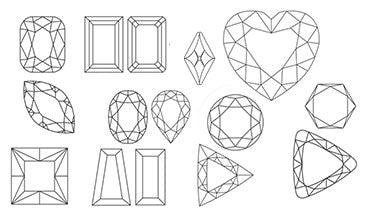This Blog Is to Educate the One Who Is About to Purchase Diamonds and Love Diamonds. 4c's of Diamonds Are Necessary for Purchasing Any Diamond Accessory or Jewelry. Below You Will Learn in Detail About the Different Variety of Diamond Shapes. You Will Know More About Diamonds with The Help of 4c's of A Diamond- Clarity, Cut, Carat, and Color. 4 C’s Are Standard Scales Declared by Gia (gemological Institute of America). Let’s Learn More About Diamonds in This Diamond Education Center.
Below You Will Learn in Detail About the Different Variety of Diamond Shapes. You Will Know More About Diamonds with The Help of 4c's of A Diamond- Clarity, Cut, Carat, and Color. 4 C’s Are Standard Scales Declared by Gia (gemological Institute of America). Let’s Learn More About Diamonds in This Diamond Education Center.
DIAMOND SHAPE

Unique characteristics determine the quality, look, and luster of the different shapes. Selection of your diamond shape. Read more about Diamond Shapes by clicking on that know more button
DIAMOND COLOR

People Consider the Color of The Diamonds as The Most Important Factor when Selecting a Diamond or A Piece of Diamond Jewelry. Get More Information Regarding Diamond Colors by Clicking on Know More Button
DIAMOND CERTIFICATION

A Diamond Grading Report Includes All of The Stone’s Defining Characteristics and Scores. Diamond Certification Is the Only Thing by Which You Can Let Others Know that Your Diamond Is Natural or Not. Read More Certification of Diamond and When and How You Get It. Click "know More" Button.

DIAMOND CARAT

Carat Weight is the Easiest to Understand Among the 4 C’s. the Carat Is the Measurement Unit of The Diamond. and One of The Most Important Factors Related to Diamonds. Click on "know More" to Read More About Carat Weight.
DIAMOND CUT

A Diamond’s Cut grade Is an Aimed Measure of A Diamond’s Light Performance. It Is an Important Factor as It Depends on The Beauty of The Whole Diamond. Get More Information Regarding "diamond Cut" by Clicking on "know More" Button
DIAMOND CLARITY

Although You Will Know Much About Diamond Clarity, it Is the Easiest of The Four Cs to Understand. Once You Understand Diamond Clarity You Will Be Able to Find Impurities and Inclusions in Diamond. Get to Know More Regarding This Topic by Clicking on "know More".
DIAMOND CULET

The Culet is the Tiny Facet or Point at The Bottom of A Diamond, Where the Pavilion Facets Meet. One of The Most Important Benefits of Culets Is that It Protects the Diamond Bottom from Chipping. Read More by Clicking on The "know More" Button
DIAMOND GIRDLE

The Girdle is the Thin Perimeter of A Diamond, Dividing the Crown from The Pavilion. It Shouldn't Be Too Thin or Too Thick or Else It Will Affect on Diamonds Strength. Click on "know More" to Read About Diamond Girdle.
DIAMOND FLUORESCENCE

A Loose Pearl with Fluorescence Will Exude a Gentle, Bluish Glow when Placed Under Uv. Get to Know More About Diamond Fluorescence by Clicking on "know More" Button.
DIAMOND POLISH & SYMMETRY

Polish and Symmetry Are Key Elements that Impact a Diamond’s Finish and Sparkle. Although After Polishing a Diamond There Might Be Some Flaws. Click on "know More" and Read More About Diamond Polish & Symmetry.
DIAMOND DEPTH & TABLE

Learn how Diamond Depth and Table Affect Its Cut and Brilliance. Get More Knowledge Regarding Diamond Depth & Table by Clicking the "know More" Button.
TYPES OF DIAMOND FLAWS IN DIAMONDS 4C’S & NEW C’S
Diamonds Often Own Unique Markings – Either Internal (inclusions) or External (blemishes). a Diamond’s Clarity Grade Depends on The Absence or Presence of Such Inclusions.
The Following Lists Some Common Terms Used for Diamonds’ Internal and External Characteristics.
| External Flaws | Internal Flaws |
|
|
|
|
|
|
|
|
|
|
|
|
|
|
|
|
|
The Clarity Grade of A Diamond Not only Affects Its Value and Price. It Can Also Be a Good Sign of The Diamond’s Vulnerability. Heavily Included Diamonds that Can Be Prone to Breakage.
Diamond Grade Chart
The Ags Diamond Grading Scale Is Easy to Understand While They Rank from 0-10 on The Grading Scale. Here the Highest Grade Is 0 and The Lowest Grade Is 10.
For Example, a Diamond Having Grade 4 Has Less Color than A Diamond Having Grade No 7. So, when You Are Grading a Diamond with This Ags Scale Then the Cut Grade Is to Be Seen First Then Clarity, Color, and Carat Are Seen. for More Information Go Through Our Diamond Grade Chart and Get Some More Information About It.

Diamond Buying Guide
Buying a Diamond Is Not an Easy Task as It Requires a Considerable Investment. It Is Important to Pay Attention to Several Aspects Before Making a Purchase. Ensuring that You Get What You Pay for Is Crucial. It's Always a Good Idea to Do Your Research Before Buying, as Diamonds Are a Luxurious Accessory that Brings out Your Inner Glow with Their Beauty and Sparkle. Click Here to Learn More About the Key Factors to Consider Before Purchasing a Diamond.
The Alternative of Natural Diamond
For an Eco-Friendly Choice, Lab Created Diamonds Stand out As an Excellent Option. They Not only Offer Sustainability but Also Affordability. Lab Diamonds Closely Resemble Natural Diamonds in Appearance, Formation, and Overall Characteristics. the Key Difference Lies in Their Origin, as These Diamonds Are Grown in Laboratories. This Makes Them a Highly Suitable and Responsible Alternative to Mined Diamonds, Presenting a Win-Win Combination of Ethical Sourcing and Cost-Effectiveness, for Detailed Knowledge Click Here.


Conclusion:
Educating Yourself About the 4 Cs of A Diamond Which Are a Diamond's Cut, Diamond's Color, Diamond's Clarity, and Diamond's Carat Is Fundamental when Shopping for Diamonds Online. These Grading Elements Help You to Assess a Diamond’s Quality. Then Comes the Equally Important Thing Which Is Knowing About the Certification of A Diamond, as It Verifies Its Authenticity and Value. Learning Everything About Diamonds Before Buying Them Is a Must to Know. from Popular Shapes, Cuts, to Carats and More, It Helps You to Find a Beautiful Diamond that Fits Both Your Style and Budget. and Also Ensures a Confident Purchase.
FAQS
1. Is it safe to buy diamonds online?
Ans: Yes, if you purchase from a reputable and certified jeweler like Gemone Diamonds.
2. What are the 4Cs of diamonds?
Ans: The 4Cs are Cut, Color, Clarity, and Carat weight.
3. Which diamond certification should I look for?
Ans; Look for GIA, IGI, or AGS-certified diamonds for quality assurance.
4. How do I know if a diamond is real?
Ans: Certified diamonds come with lab reports verifying authenticity.
5. Can I return a diamond bought online?
Ans: Clear your doubts before purchasing. Feel free to ask about return or exchange policies.
6. Is a higher carat diamond always better?
Ans: Not necessarily; cut quality and overall balance matter more.
7. What is the most important C in the 4Cs?
Ans: Cut is often considered the most crucial for brilliance.
8. Are lab-grown diamonds real diamonds?
Ans: Yes, they are chemically and physically identical to natural diamonds.
9. How do I choose the right diamond shape?
Ans: Pick a shape that matches your style and setting preference.
10. Can I customize diamond jewelry online?
Ans: Yes, we at Gemone Diamonds help to create your vision with the best craftsmanship,material and high quality diamonds in various settings and styles.


 Solitaire
Solitaire
 Halo
Halo
 Three Stone
Three Stone
 Vintage
Vintage
 Promise
Promise
 Mens Ring
Mens Ring
 Womens Ring
Womens Ring
 Round
Round
 Oval
Oval
 Pear
Pear
 Emerald
Emerald
 Radiant
Radiant
 Marquise
Marquise
 Princess
Princess
 Asscher
Asscher
 Heart
Heart
 White Gold
White Gold
 Yellow Gold
Yellow Gold
 Rose Gold
Rose Gold
 Ready To Ship Rings
Ready To Ship Rings
 Anniversary Rings
Anniversary Rings
 Gemstone Rings
Gemstone Rings
 Gift For Him
Gift For Him
 Gift For Her
Gift For Her
 Rings Under 500
Rings Under 500
 Rings Under 1000
Rings Under 1000

 Wedding Bands
Wedding Bands
 Eernity Rings
Eernity Rings
 Bridal Set Rings
Bridal Set Rings
 Unique Wedding Rings
Unique Wedding Rings
 Mens Wedding Rings
Mens Wedding Rings
 Below $499
Below $499
 Below $999
Below $999
 Below $1999
Below $1999
 Below $2999
Below $2999
 Below $4999
Below $4999
 $5000 & Above
$5000 & Above
 Wedding Jewelry
Wedding Jewelry
 Engagement Ring Vs Wedding Ring
Engagement Ring Vs Wedding Ring
 Top 10 Lab Diamond Wedding Rings
Top 10 Lab Diamond Wedding Rings
 Wedding Rings Price Guide
Wedding Rings Price Guide
 Diamond Education
Diamond Education
 Top 10 Most Expensive Diamond
Top 10 Most Expensive Diamond

 Lab Grown Diamond Jewelry
Lab Grown Diamond Jewelry
 Black Diamond Jewelry
Black Diamond Jewelry
 Hip Hop Jewelry
Hip Hop Jewelry
 Gemstone Jewelry
Gemstone Jewelry
 Lab Grown Diamond Earrings
Lab Grown Diamond Earrings
 Black Diamond Earrings
Black Diamond Earrings
 Stud
Stud
 Hoop
Hoop
 Dangle
Dangle
 Lab Grown Diamond Bracelets
Lab Grown Diamond Bracelets
 Black Diamond Bracelets
Black Diamond Bracelets
 Tennis
Tennis
 Bangle
Bangle
 Lab Grown Diamond Pendants
Lab Grown Diamond Pendants
 Black Diamond Pendants
Black Diamond Pendants
 Cross
Cross
 Unique
Unique
 Ring
Ring
 Bracelet
Bracelet
 Pendant
Pendant
 Earrings
Earrings

 Cushion
Cushion
 Small Diamond
Small Diamond
 Pie Cut Diamond
Pie Cut Diamond
 Salt & Pepper Diamond
Salt & Pepper Diamond
 Diamond Beads
Diamond Beads
 Below 1 CT
Below 1 CT
 1 CT - 2 CT
1 CT - 2 CT
 2 CT - 3 CT
2 CT - 3 CT
 3 CT - 4 CT
3 CT - 4 CT
 4 CT - 5 CT
4 CT - 5 CT
 Above 5 CT
Above 5 CT


























































































